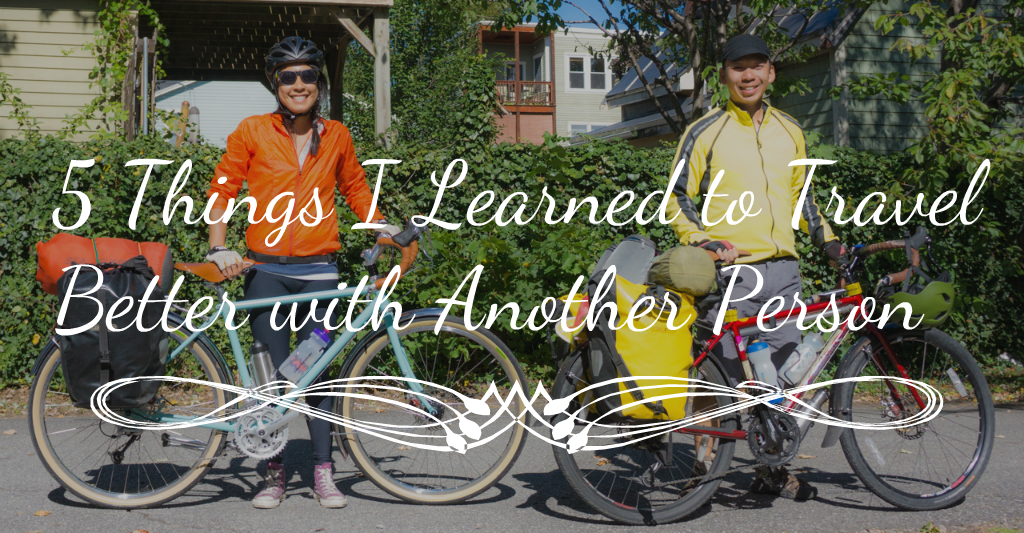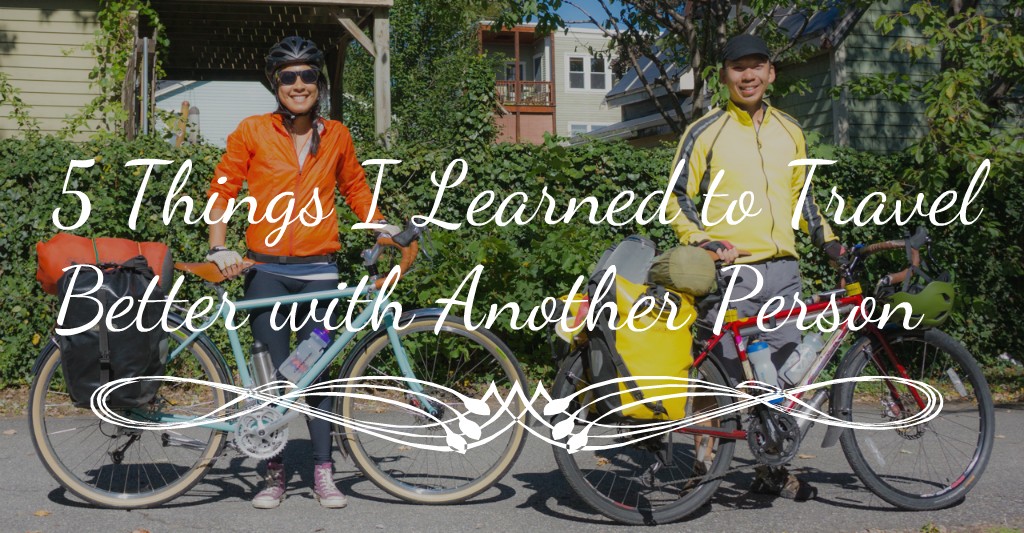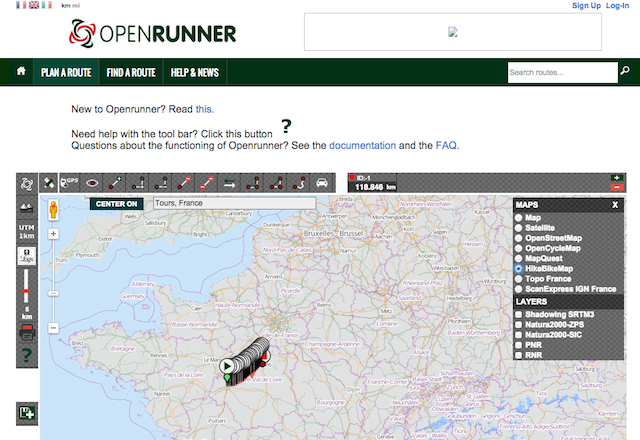
25 Aug 5 Things I Learned to Travel Better with Another Person
If you have been following my journeys on this blog, you will know that I go on bike tours with at least 1 person or more each time. I suppose it’s a natural thing for me, as I seem to have others who would like to be part of my journey whenever I have a destination or trip in mind. Most of my trips are enjoyable, but there are the longer ones that could put some strain on one’s relationship with their travel partner. That is why I am going to lay down some guidelines for myself (and perhaps help you) on future bicycle tours that will hopefully make things easier to manage.
1. Everybody needs to be part of the route planning
I have been part of bike tours where I am the sole route planner or I defer the planning to another person. While both of these scenarios have its merits and drawbacks, I think the best way to resolve issues with directions is everyone has a hand in it. Some might say that this is redundant, but I think it is more helpful as it gives each person an opportunity to look over the route and point anything out that they may have issues with. You can have one person in charge of the overall route, but having daily route meetings are necessary. If possible, have turn-by-turn directions so that there are no second guessing. Of course, this wasn’t possible at all during my trans-Europe trip, but we did have rules about waiting for each other on any turns off the route.
Another point about routing I would like to make is to have an established get lost work flow. The most important thing to tell yourself is that it is nobody’s fault when you get lost, so don’t start blaming each other. You will absolutely get lost in every trip you go on, even trips that you’ve been on before, so just accept it and breathe. Secondly, know your tendencies. What I mean by that is, are you the heads down look at the map and try to figure it out on your own type or are you the type who would rather find someone to help? Communicate which type of problem solver you are with your partner and find out what your partner tends to do. I think both problem solving methods are valuable and having a way to deal with them will help alleviate any communication problems. Know when to step in and problem solve your way or listen to what your partner has to say. Let go of that control or stubborn habit.
2. Establish a miles per day average and limit
Before you even start planning your route, establish what your miles per day average and limits are. I mean realistically declare what you are most comfortable with and err on the side of comfort. You are certainly going to get stronger, but don’t agree to average a higher distance than you are comfortable with. Why is this important? This will help plan out the itinerary for the trip. You are going to travel as fast or as far as the slowest member of your group. This will weed out any constraints you may have and filter out the travel companions that are not compatible with you. Sometimes it’s easier to know ahead of time and say, “I’m out!”
Even though most bicycle tourists would say they don’t like to stick to a schedule or timeframe, the harsh reality is that there is always a time constraint, and that will some how affect your trip one way or another. Things like figuring out where you’ll be at the end of the day is important to know in case you want to line up a Warmshower’s request a few days ahead of schedule, or if the town you end up at will have a market to buy food. Riding limits will help decide if your day may require extra miles for any given reason.
Know your limits and be honest about it.
 3. Have a budget that you both agree on and stick to it
3. Have a budget that you both agree on and stick to it
One of the other issues in bicycle tourism is the financial side of things. Make sure you have a good estimate on your budget. Find out what your cost per day is going to be and communicate this with your riding partner. Be sure to put more padding or cushion to this number. A good rule of thumb is to have a 10-20% overflow to account for unpredicted costs, as well as insurance cost if you’re going on a long trip. This number should be comfortable for everyone.
What we did on our trans-Europe trip was establish what we called a “pushke” fund where we pooled our money together in one bank account and withdrew money from this account whenever we needed it for accommodations or food on the trip. This worked well until we blew our budget for the trip. That is why budgeting and a reviewing it is important so everyone knows how we are doing financially. I’m planning to adapt this financial pooling on future trips so that it resolves the many issues as to who is paying for what without keeping mental tallies.
I also recommend using a Charles Schwab account for this. On my trans-Europe trip, I had no problem using this card everywhere, and they refund the foreign ATM transaction fees. I am in no way affiliated with Charles Schwab. I’m just a fan of their checking account.
 4. Line up your accommodations expectations
4. Line up your accommodations expectations
Understand each other’s idea of sleeping accommodations. Be sure to have accommodation hierarchy planned out. This is figuring out what the orders of accommodations that you are willing to do from highest to lowest priorities. For example, here is a hierarchy I use on several trips:
- Paid camping
- Warmshowers / Couchsurfing / Friends place
- Hostels
- Guest houses / Pensions
- AirBNB
- Motel / Inn / Hotel
- Wild camping
Having thus established accommodation priority, you know each other’s idea of comfortable accommodations and try to avoid the ones that are lower on priority, unless it is absolutely necessary during the planning process. I personally don’t like wild camping so that is why it is at the bottom of my list, but if we are out of ideas, I will reluctantly agree. I also try to avoid hotels due to budget busters, but sometimes hotels are absolutely necessary when you’ve been in the wild for so long.
Be sure to figure out where your partner ranks each accommodation preference. This can save you from a whole lot of disagreements.
How to Find Bike Touring Accommodations
5. Find out about each other’s food preferences
One of the most overlooked things that I began noticing is the food preferences that people have when they are bicycle touring. Save yourself the trouble and travel with someone with similar eating preferences. I am a foodie and enjoy eating other cultural food. I realized that I travel best with someone who have similar food taste. It is just easier to find restaurants that way.
Another thing to keep in mind is what kind of staple foods or eating preferences you may have. For example, do you both like peanut butter on bread? If so, you need to make sure you always have a jar ready with some bread when you need that snack for the last-minute push to camp. Things like this will become a routine while you’re on the road. You’ll know what to do to keep the other person and yourself happy at all time.
Be sure to communicate any food preferences or routine you must do everyday, so that touring partner(s) are aware of them.
Final Thoughts
Behind all 5 aspects of things to consider, you will notice that not only do you need to have open communication with your partner(s), but they also require you to have patience, and the willingness to do things that you may not want to do. Don’t dismiss suggestions or plans because you are not comfortable with them right away. Some of these experiences may bring wonderful opportunities that you would have never thought possible. For example, I probably would not have gone and enjoyed all the wineries on my own, but having my pal Harry there, truly enhanced the trip and my views of wine for the rest of my life.
Do you have any tips on traveling with another person? Please share in the comments below. Would love to know if you have similar challenges and learnings like I did.











Sorry, the comment form is closed at this time.